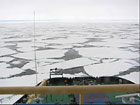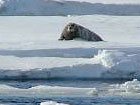

 | ||||||||||||||||||||||
|
|
Journals 2007/2008Kathy Couchon
May 31, 2007 Latitude/Longitude: 81°18' N, 012°12' E It was within an hour of retiring last night when I awoke to a very familiar sound, ice against Oden's hull. I had expected that it would take us more time to reach the ice edge, but not so. Suddenly I was no longer tired, but had to get up, so mesmerized was I by the endless floes of ice stretching out ahead. For the next hour and a half I wandered the bridge, a very special place on the ship. With windows and views in almost all directions, you get a constantly changing panorama. Once we reach ice, there is the very real possibility of sighting polar bears and everyone would like to see one. Windblown tracks and patches of blood, perhaps left from a meal, show that one had been by, but there was no sighting. It is with mixed emotions that the science team views the ice; the goal is to test equipment that will be used later in the summer to research hydrothermal vent communities in icy Arctic waters, and the ice presents considerable risks and challenges to the equipment and methodology. To transit through the ice to the test site, the Master of the vessel follows open pathways, or leads, through the ice trying to minimize the amount of ice-breaking necessary. Today's goal was to reach the test site, in an area north of Spitzbergen, to begin the test trials. In the brilliance of sunlight on snow and ice, the helicopter team took off on two ice reconnaissance missions this morning to determine the size and movement of ice floes ahead of us. It is of vital importance to know how large the ice floes are and in which direction they are moving. This not only helps the ship navigate through the ice but will determine where the test trials will take place. I make special mention of the sunlight, because it is a rarity in the high Arctic Ocean. There may be 24 hours of daylight, but it usually in the form of muted light in foggy conditions. When the sun does shine, it is a chance to capture the true majesty of the icescape. It is a time of "photo-op frenzy," anyone awake and not on duty rushes to the decks with cameras clicking. The landscape may seem to be static to those who have never experienced it, but truly it is an ever-changing entity. The big excitement of the afternoon was watching a large seal contently lounging on the edge of the ice. It certainly looked like an appetizing lunch for a polar bear, but there were no takers. I must make special note of tonight's dinner menu. Traditional Thursday night dinner in Sweden calls for pea soup and pancakes. The thin pancakes are served with jam and ice cream, or cheese, and a sweet warm alcohol drink called punch. These Thursday dinners are especially significant on long Arctic expeditions because they are a way to mark the passing of time and to keep track of the weekdays. When you never see darkness and one day's work is very much like another's, it is easy to lose track of the day. It also makes for a bit of a festive air. The science plans for today called for testing pretty much all of the equipment; casting the CTD rosette, running the multibeam echosounder, and then deploying both the CAMPER unit and the AUVs. As it turned out, the science team succeeded in dropping the CTD and the running the echosounder. It was late night before plans were made for setting out sound transponders in the water, preliminary to launching the AUVs, so the timeframe for AUVs was pushed into the early hours of tomorrow morning. There is much anticipation about putting the vehicles into the water, but rather than wait up until CAMPER deployment time, I go to bed with the promise of a wake-up call when something happens. Final thought of the day: perhaps tomorrow we will see a polar bear.
|
|||||||||||||||||||||



